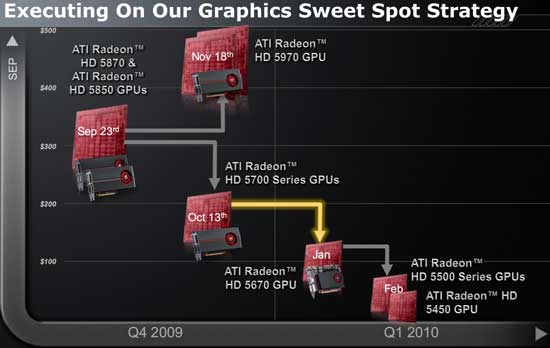
Original Link: https://www.anandtech.com/show/2917
AMD's Radeon HD 5670: Sub-$100 DirectX 11 Starts Today
by Ryan Smith on January 14, 2010 12:00 AM EST- Posted in
- GPUs
After a holiday break, AMD’s staggered launch of the Evergreen family picks back up today with the launch of the Radeon HD 5670. The 5670 marks the desktop launch of Redwood, the 3rd chip in the Evergreen family, designed to fit in below the Juniper chip that powers the Radeon HD 5700 series.
| ATI Radeon HD 5750 | ATI Radeon HD 4850 | ATI Radeon HD 4770 | ATI Radeon HD 5670 | ATI Radeon HD 4670 | |
| Stream Processors | 720 | 800 | 640 | 400 | 320 |
| Texture Units | 36 | 40 | 32 | 20 | 32 |
| ROPs | 16 | 16 | 16 | 8 | 8 |
| Core Clock | 700MHz | 625MHz | 750MHz | 775MHz | 750MHz |
| Memory Clock | 1.15GHz (4.6GHz data rate) GDDR5 | 993MHz (1986MHz data rate) GDDR3 | 800MHz (3200MHz data rate) GDDR5 | 1000MHz (4000MHz data rate) GDDR5 | 1000MHz (2000MHz data rate) GDDR3 |
| Memory Bus Width | 128-bit | 256-bit | 128-bit | 128-bit | 128-bit |
| Frame Buffer | 1GB / 512MB | 1GB / 512MB | 512MB | 1GB / 512MB | 1GB / 512MB |
| Transistor Count | 1.04B | 956M | 826M | 627M | 514M |
| TDP | 86W | 110W | 80W | 61W | 59W |
| Manufacturing Process | TSMC 40nm | TSMC 55nm | TSMC 40nm | TSMC 40nm | TSMC 55nm |
| Price Point | $129 - $149 | $99-$129 | $129 | $99 / $119 | $60-$90 |
AMD has been relatively straightforward in designing the Evergreen family. Each chip is half of its bigger brother. This means that the Redwood chip and the 5670 is in most ways half of a Juniper/5770: half the SIMDs (400), half the ROPs (8), half the texture units (20), etc. The core clocks are also slightly changed compared to the 5870 and 5770; here we have a core clock of 775MHz instead of 850MHz as found on those cards. So on paper, the 5670 is going to be slightly less than half of a 5770 in performance.
The one hardware unit that hasn’t been halved is the memory bus – we still have the same 128-bit GDDR5 memory bus as found on the 5770, but here it’s clocked at a 4GHz data rate. So the 5670 has a higher bandwidth-to-compute ratio than the 5770 does.
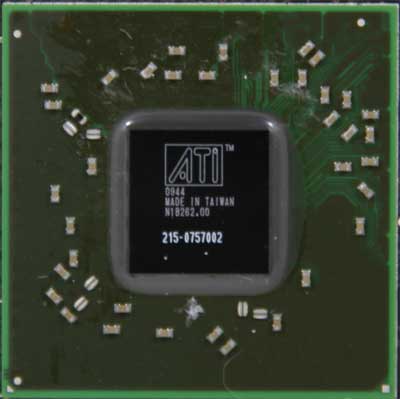
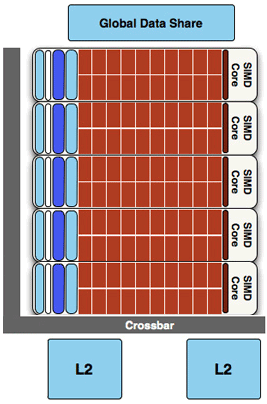
In nearly chopping Juniper in half, AMD has brought the transistor count down from 1.04B to 627M. Those transistors occupy a space of 104mm2, which is understandably smaller than the 5770, but also smaller than the RV730 GPU that powers the Radeon HD 4670, the card the 5670 replaces. This smaller die brings load power down to 61W, and idle power down to 14W.
While most of the functional units have been halved, the feature set remains otherwise unchanged from the rest of the 5000 series. DirectX 11, UVD2 video decoding, angle-independent anisotropic filtering, HDMI bitstreaming, and supersample anti-aliasing are all accounted for. Eyefinity is also here, using a slightly different port configuration to continue bringing support for 3 monitor Eyefinity.
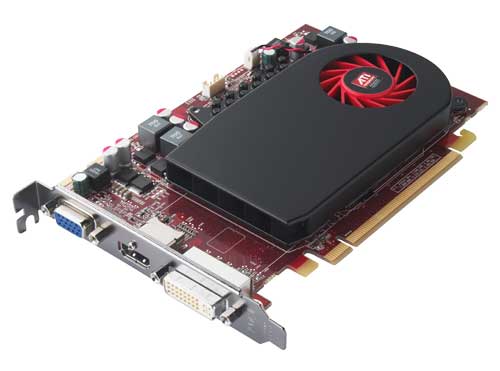
At $99, the 5670 is intended to stake out the all-important sub-$100 position for video cards, which is a big price point for price-sensitive buyers and OEMs. Bear in mind that the entire sub-$100 market encompassed 2/3rds of all video card sales last quarter, according to AMD and Mercury Research. Given the low transistor count and small die size of the 5670, we expect that AMD will have a lot of price latitude to work with going forward – as 40nm production costs and GDDR5 costs come down, this board should be cheaper to make than the 4670 ever was.
AMD considers the chief competition for this board to be the NVIDIA GeForce GT 240, which we reviewed last week. However this price point also brings AMD into competition with last year’s parts: the GeForce 9800 GT and Radeon 4850. The former is in good supply, and the latter still available enough at this moment to be a viable alternative. As we’ll see, this is by no means a slam-dunk for AMD today.
Coming from CES, we had a chance to talk to vendors about the 40nm TSMC situation, which has been a thorn in AMD’s side since the launch of the 4770 last year. What we’re hearing is that the situation is improving (which is why 5800 series cards are finally usually in stock) but that it’s still not as good as everyone would like. For this launch there are 50k+ cards, which should be more than enough to satisfy demand. We don’t expect there to be any supply issues with the 5670.
Meet The 5670
Today’s launch is the Redwood based Radeon HD 5670. The 5670 is a full Redwood card, with all of its functional units enabled and running at its “full” clockspeed. The card we’re looking at is clocked at 775MHz core, and 1GHz(4GHz data rate) on the GDDR5 RAM. With a 128-bit memory bus, this gives the card 64GB/sec of memory bandwidth.
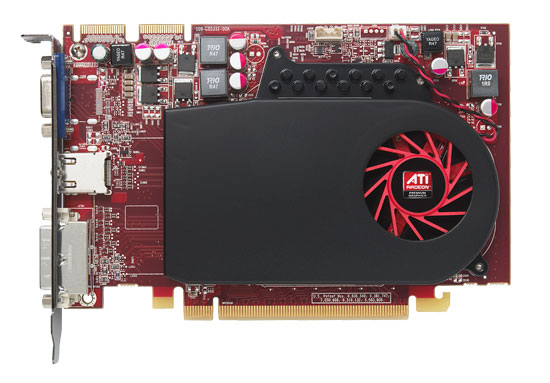
AMD stock photo, our sample boards are black and don't have CF connectors
AMD will be launching the card in a 512MB and 1GB configuration. The $99 card we’re looking at is a 512MB model, while the 1GB model will run $15-$20 more.
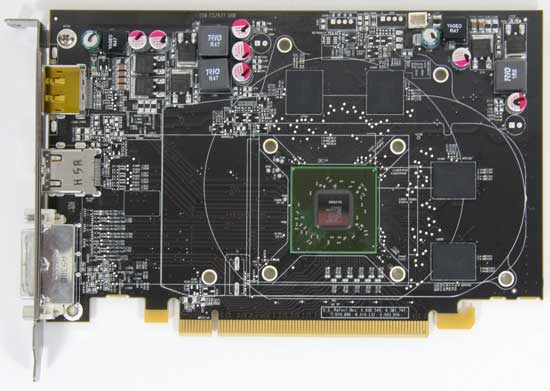
Attached to the card are 4 128MB Hynix GDDR5 RAM chips. These chips are specified for a 4GHz data rate, so AMD is only finally pairing up 5000-series cards with appropriately fast RAM. What this means is that unlike the 5700 and 5800 series, there won’t be any freebie memory overclocking to take advantage of the gap between the card’s clocks and what the RAM is specified for. What you see is what you get.
As is common for cards targeted at the sub-$100 price range, the 5670 runs sans external power. AMD puts the TDP for the card at 61W, which compares favorably to the 70W of the GT 240 that we saw last week. AMD tells us that they were merely designing this card to be under 75W, and that the 61W TDP of the shipping product is a good bit lower than they had been planning on.
With the lower power usage of this card, the need for a dual-slot cooler (and the 5000 series distinctive shroud) is gone. The 5670 is equipped with a slightly larger than normal single-slot blower, which blows air towards the front of the card. We call this cooler slightly larger than normal since AMD has extended the heatsink portion slightly to cover all of the GDDR5 RAM chips on the card, as evidenced by the heatsink jutting out of the top. This is an interesting design choice from AMD, since other cards like the 5750 do not apply any cooling to the GDDR5 RAM chips. This does leave us wondering whether cooling the RAM is necessary, or if AMD is doing it for cosmetic reasons.

The card measures at 6.61”, and finally drops AMD’s traditional Eyefinity port configuration. By moving to a single slot, AMD has dropped the 2nd DVI port, leaving the card with a DisplayPort, an HDMI port, and a dual-link DVI port. The card will be able to drive a second DVI monitor using an HDMI-to-DVI adapter, although only a single link. The 5670 still has full Eyefinity capabilities, and a 3rd monitor can be hooked up to the DisplayPort for that task. AMD tells us that the Redwood chip can actually drive 4 monitors, but none of the launch cards will configured for that (not that the 5800 cards were either). AMD’s ideal Eyefintiy configuration for this card is to pair it up with a trio of cheap 16:9 19” monitors, although as we’ll see the card doesn’t really have enough power for gaming like this.
The need for an active DisplayPort adapter is still an issue however, and at $99 the adapters are as much if not more than the card itself. At this point the best solution is a DisplayPort native monitor, but those are still fairly rare and seldom cheap.
5500 Series and 5450 Pre-Announcement
Along with today’s launch, AMD is also pre-announcing the 5500 series and the 5450. We say pre-announcing as they’re not launching the cards today, nor are they showing off the complete specifications of the cards. Today is an announcement of what they’ll be launching in February, the 6th and final month in their 6 month 4 chip launch window for the Evergreen family.
We’ll start with the 5500 series. There is one card pre-announced thus far, which we expect will get a real name (e.g. 5570) at launch. The 5500 series is specified for less than 50W load power, and will be a low-profile actively cooled card. In a full-height computer, a 3rd display output port can be attached, giving the card the ability to drive 3 monitors in an Eyefinity configuration.

The other card is the 5450, which is another low-profile card, but this time passively cooled. It too can drive 3 monitors in Eyefinity mode when put in a full-sized case to allow a 3rd display output. We don’t know what the power usage is, beyond the fact that AMD is calling it an “ultra low power” card.

Both of these cards will have the full 5000 series feature set, most importantly including audio bitstreaming. This should make either of these cards the great HTPC card we’ve been expecting to come out of the 5000 series, depending on how much rendering power you need.
As we stated before, both of these cards will be launching sometime in February. We do know more about these cards, but at this point we’re not allowed to talk about them. What we can suggest is that you look at our Mobility Radeon 5000 article, where AMD announced Redwood and Cedar in mobile form ahead of the desktop cards, and then take a very close look at this slide of AMD’s chip stack. The astute among you should be able to infer some additional information about these forthcoming cards.
The Test
For the 5670 launch, AMD has issued a new set of drivers, version 8.69. These identify themselves as the Catalyst 10.1 beta drivers, although we’re not sure just how much this is true.
| CPU: | Intel Core i7-920 @ 3.33GHz |
| Motherboard: | Intel DX58SO (Intel X58) |
| Chipset Drivers: | Intel 9.1.1.1015 (Intel) |
| Hard Disk: | Intel X25-M SSD (80GB) |
| Memory: | Patriot Viper DDR3-1333 3 x 2GB (7-7-7-20) |
| Video Cards: |
AMD Radeon HD 5970 |
| Video Drivers: |
NVIDIA ForceWare 190.62 |
| OS: | Windows 7 Ultimate 64-bit |
Crysis: Warhead
Kicking things off, we’ll start with Crysis: Warhead. Warhead is still the single most demanding game in our arsenal, with cards continuing to struggle to put out a playable frame rate with everything turned up.
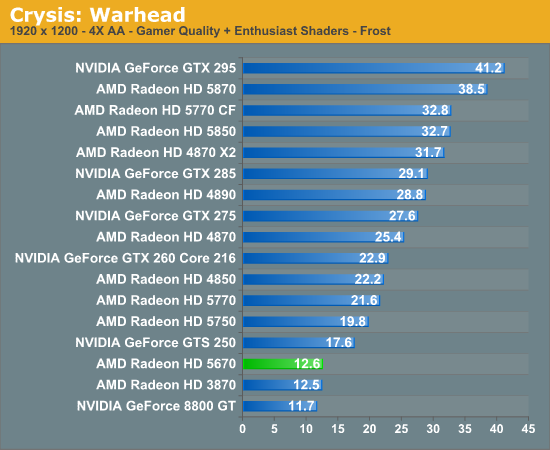
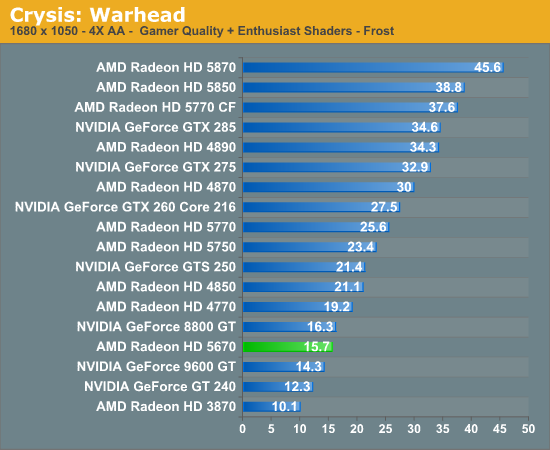
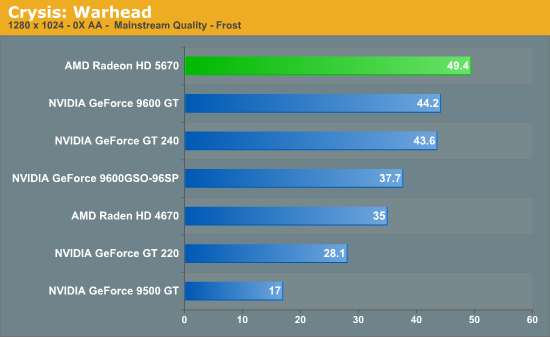
The 5670 is slow enough that it doesn’t fare well here on Crysis with the settings turned up. Crysis is a crushing game, and it’s necessary to turn the settings down to get a playable framerate.
Once we do that, it does quite well at nearly 50fps at 1280. Compared to the GT 240 it’s upwards of 25% faster, and even edges out the 8800 GT in all cases. It’s also a great deal faster than the 4670, beating it by nearly 40%. The 4850 gets the last laugh however, and handily beats the 5670.
Far Cry 2
Far Cry 2 is another foliage-heavy game. Thankfully it’s not nearly as punishing as Crysis, and for fast cards it’s possible to achieve a good framerate even with all the settings at their highest.


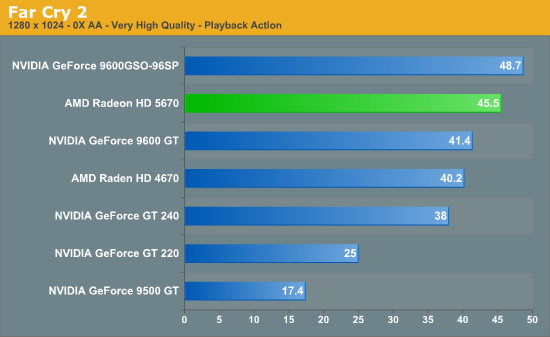
In spite of having the same amount of memory as our 8800 GT and 4850, the 5670 does rather well here, beating out every similar card, both old and new. It’s still not quite playable on our highest settings at 1680 however, coming in at the top of our “unplayable” class at this resolution.
Compared to the GT 240 it’s 25% faster, and 40% over the 4670. Compared to the next class of cards though, it’s nowhere close to the 5750 or GTS 250.
Battleforge
BattleForge is EA’s card-based online-only RTS. As the first DirectX11 title it’s of particular importance for the latest rendition of DirectX, although in this case we aren’t using any features that would be impacted by it. Even without ambient occlusion, BattleForge manages to be a rather punishing game for GPUs.
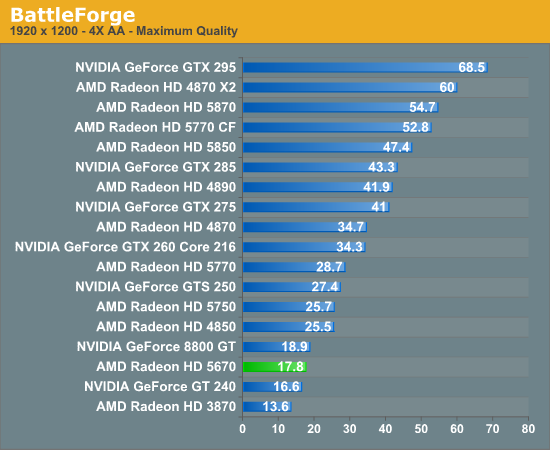
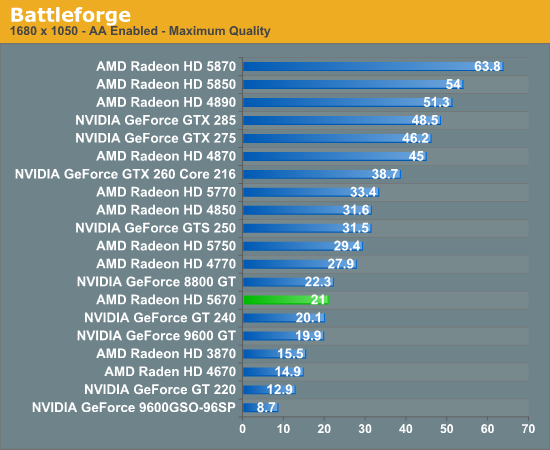

Battleforge is another game where you really have to give up some kind of quality to play at 1680 or higher. The 5670 is neck-and-neck with the 8800 GT, but the 4850 makes quick work of it.
Compared to more modern cards, the 5670 is still at the top of the $99 class, but the GT 240 is within a few frames here. The 4670 falls well behind here, with the 5670 coming out almost 50% faster in some cases.
HAWX
HAWX is another game that’s not particularly GPU-bound, which means we can turn in some high numbers.
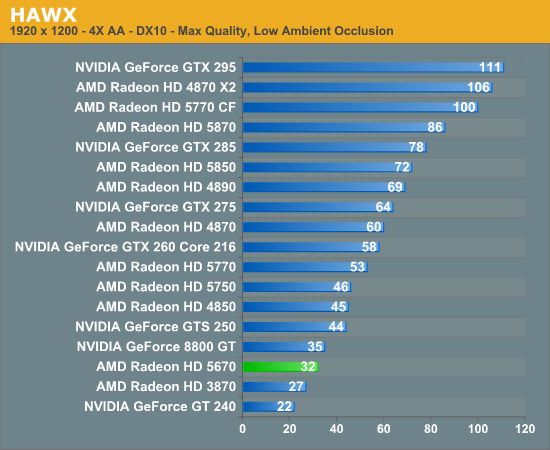
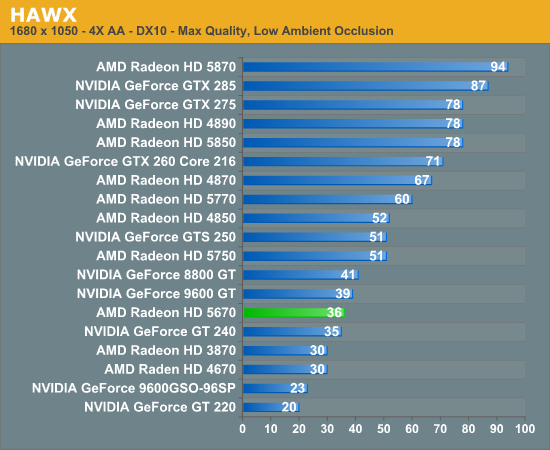
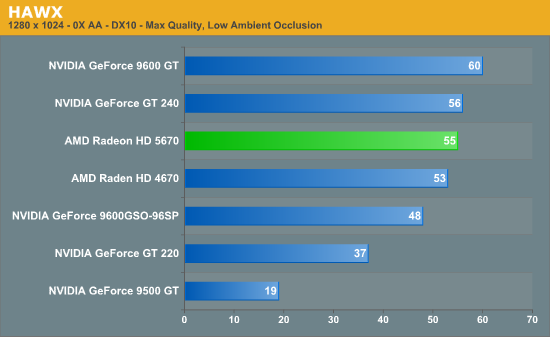
HAWX gives us some interesting results, particularly when compared to the GT 240. At very high resolutions the 5670 is well ahead of the GT 240, pushing out a 45% lead at 1920 and still maintaining a playable 32fps frame rate. On the other hand at 1280, the GT 240 comes ahead by a frame. This is fairly consistent with earlier data, and it looks like the 5670 can really pull away from NVIDIA’s newer cards at higher resolutions.
Compared to the 8800 GT and 4850, the 8800 GT maintains a comfortable lead, and the 4850 is consistently in another class altogether. Meanwhile the 4670 is fairly close here, which makes sense given that the 5670’s shader advantage is less beneficial here.
Dawn of War II
Dawn of War II is our other RTS benchmark. It’s among the more challenging games in our collection, leading to there being a definite cutoff for playability.
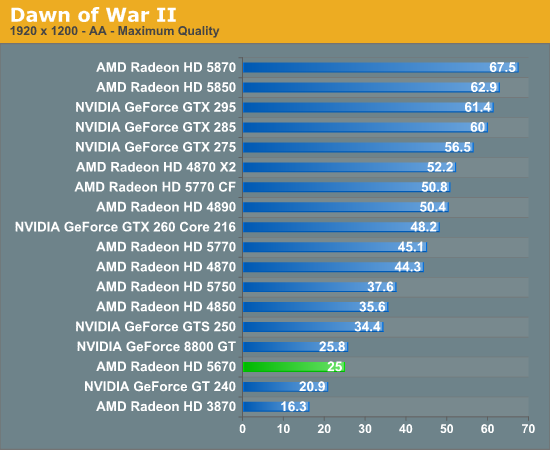
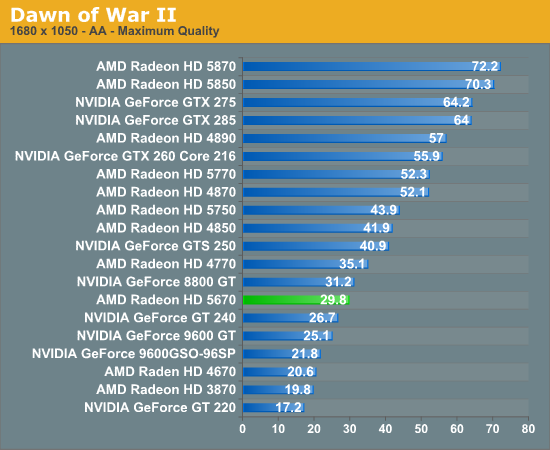
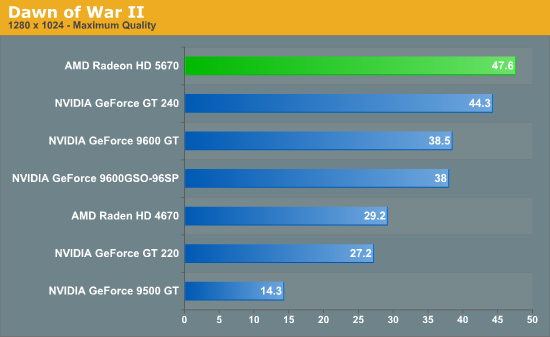
Depending on how hard of a rule the 30fps rule is for you, the 5670 either is or isn’t playable at 1680 here. At playable levels it’s about 15% faster than the GT 240, while it’s slightly trailing the 8800 GT. Meanwhile the 5670 is 50% (or more) faster than the 4670.
The 4850 gets free reign here though, and thoroughly crushes everything at all resolutions.
Resident Evil 5
Resident Evil 5 is the latest installment of Capcom’s popular survival horror. As is often the case with console ports, it’s not particularly GPU starved.
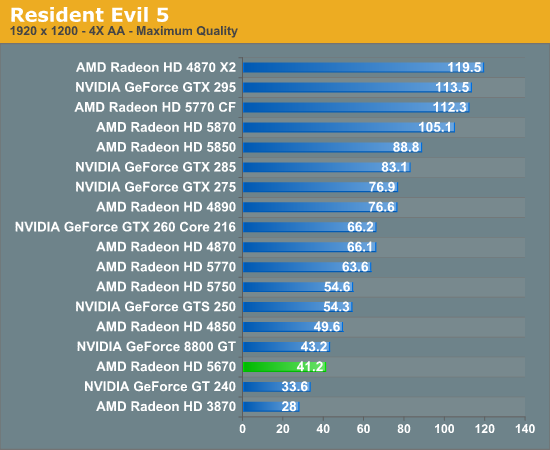
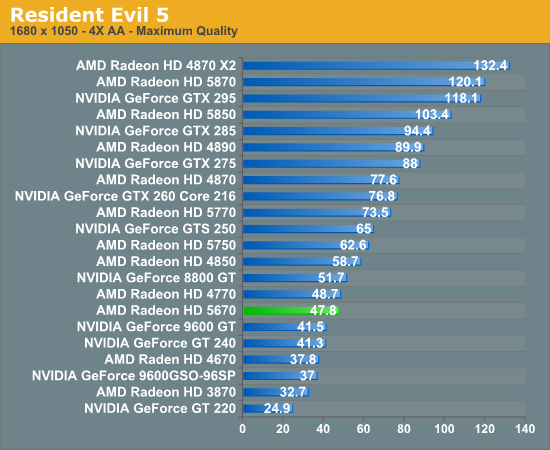
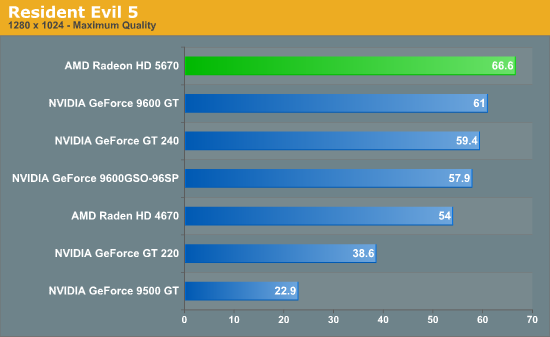
Without being GPU bound, even the 5670 can provide a solid framerate here at 1920 with anti-aliasing. At this resolution it’s a good 22% ahead of the GT 240, while trailing the 8800 GT slightly, and the 4850 is 25% ahead.
At lower resolutions the GT 240/5670 gap closes some, but the ordering doesn’t change. Meanwhile the 4670 continues to fall well behind the new 5670.
Batman: Arkham Asylum
Batman: Arkham Asylum is another brand-new PC game, and has been burning up the review charts. It’s an Unreal Engine 3 based game, something that’s not immediately obvious from just looking at it, which is rare for UE3 based games.
As Batman: Arkham Asylum implements anti-aliasing differently between AMD and NVIDIA cards, this is the one title that we do not test AA on, as doing so produces results that can’t be compared.
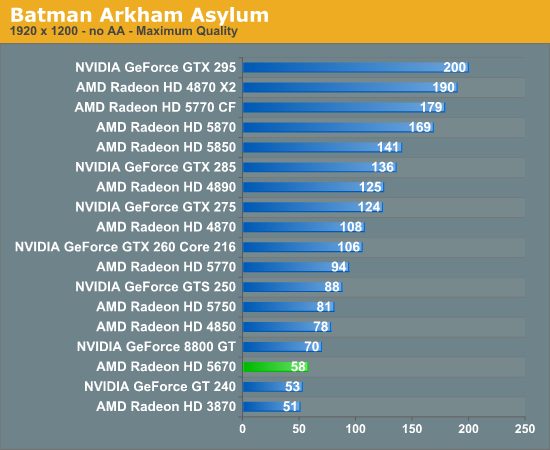
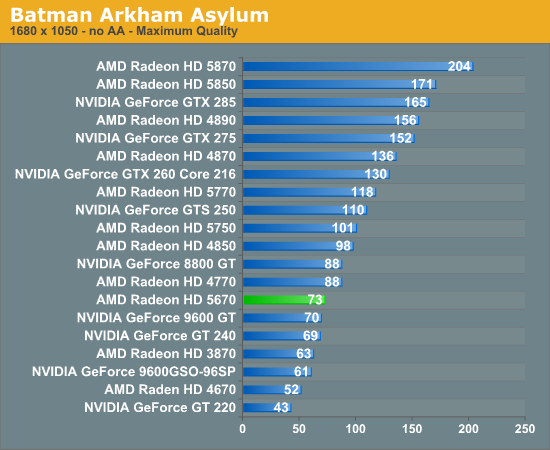
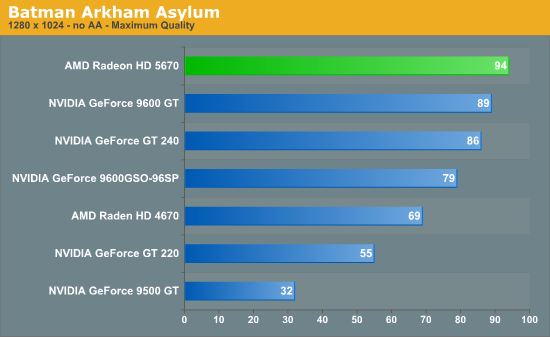
Batman is a game that the 5670 doesn’t do quite as well on. Here the 8800 GT is 20% faster, and the 4850 is faster yet. Meanwhile it’s less than 10% faster than the GT 240 in most situations, but bear in mind that without AA even 1920 is silky smooth on the 5670. The 4670 is once again the odd man out, with the 5670 coming in well ahead.
Left 4 Dead
Valve’s venerable Source engine continues to roll on with Left 4 Dead, their co-op zombie shooter. As the Source engine is CPU limited, this is another title that low-end cards can do well at.

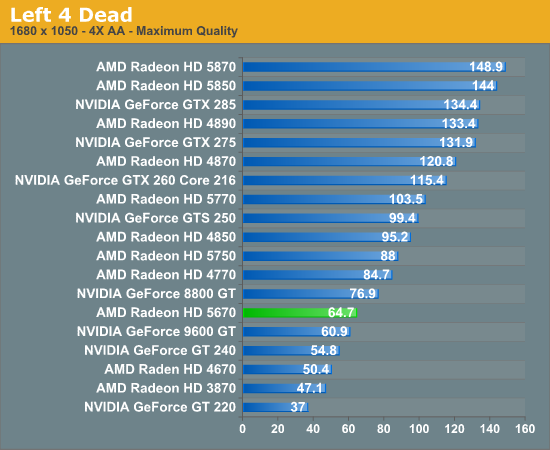
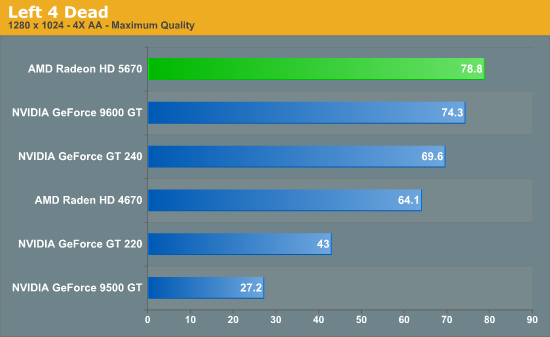
Compared to the GT 240 the 5670 can stretch out its legs and run some here, coming ahead of the GT 240 by 22% and 18% at 1920 and 1680 respectively. The cost is that the 8800 GT is 16% faster yet, and the 4850 is a good 40% faster. On the flip side, like Batman this is a game where it’s fluid even at 1920, and we get to use AA this time.
Power, Temperature, & Noise
As a note here, since NVIDIA does not offer a reference GT 240, we’re using our Asus 512MB GDDR5 GT 240 as our reference 240. It does have a dual-slot cooler, so the cooler is not directly comparable to the blower on the 5670.
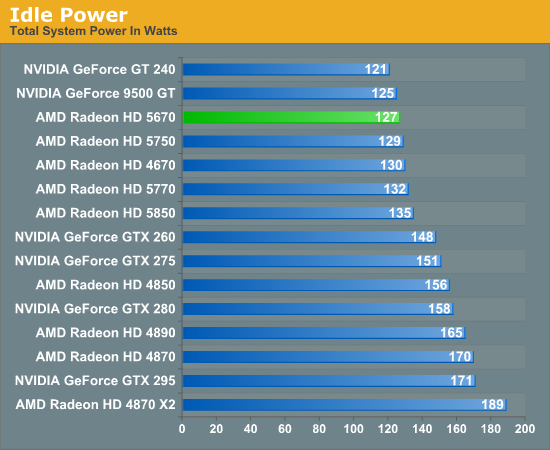
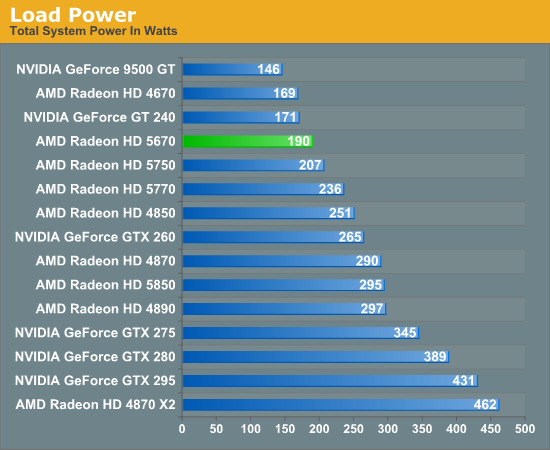
The one thing AMD can’t quite best the GT 240 at is idle power. Here the GT 240’s sub-10W idle means the 5670 idles slightly higher. With that said it’s the 3rd lowest card of all time, behind only the GT 240, and the significantly slower 9500 GT.
Load power paints a different picture however, and this is where the concept of a “power virus” pokes its head up again. The 5670 has a lower TDP than the GT 240 according to the specs published by AMD and NVIDIA - at 61W and 70W respectively - and we have no reason to doubt these numbers. But here the load power of the 5670 is much higher, by just shy of 20W. You’ll notice here that the 4670 is also much lower in spite of similar specs – all of this leads us to believe that the other cards are throttling themselves some as compared to the 5670, whose VRM protection features let it run away compared to these cards. Compared to the 5750 the data is correct, so that makes a better reference point than the GT 240 or 4670.
Accounting for these quirks, the 5670 should be between the 3rd and 2nd lowest power consuming card that we have on-hand.
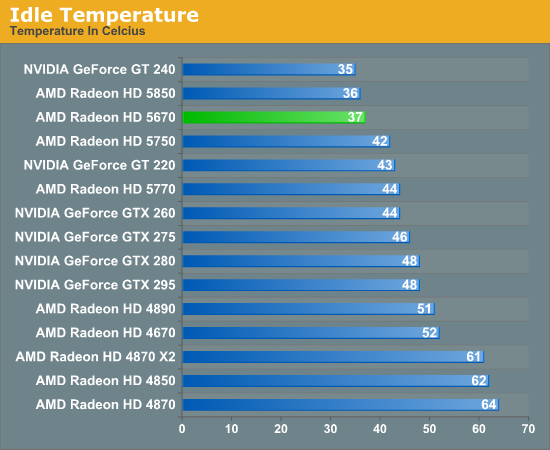
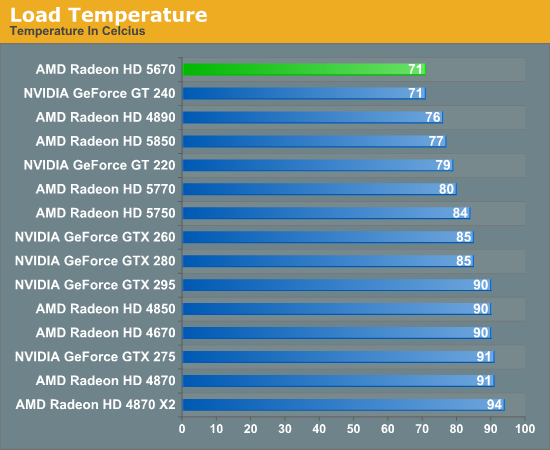
Less power usage leads to less heat, and in this case this means the 5670 once again trails the GT 240, which benefits from said lower power usage and the dual-slot cooler on our specific card. It’s still the 3rd best card however, beating everything except said GT 240 and the remarkably cool 5850.
At load, the picture looks very good for AMD. Even though we’re using a dual-slot cooler, thanks to the low load power usage we’re looking at a tie for the lowest load temperatures we’ve ever recorded. The dual-slot GT 240 ties at 71C, and we’re several degrees from anything else. The results are particularly good compared to the 4670, which was an inferno at 20C higher in this test.
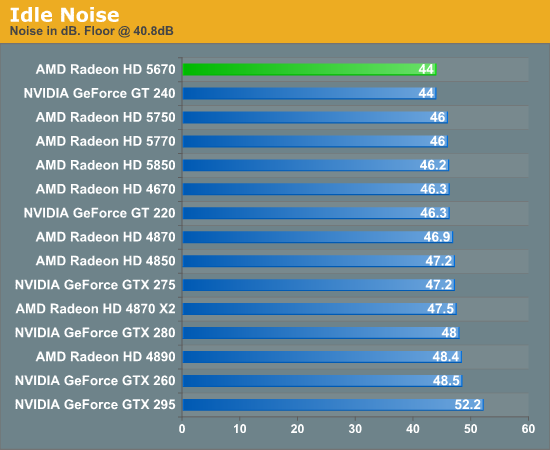
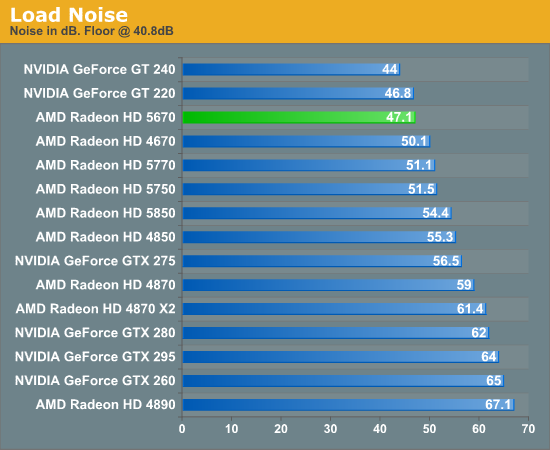
Finally there’s noise. As is the case with all of our other cards, the noise at idle is virtually indistinguishable from the noise generated by the rest of the computer.
At load the 5670 continues to be a quiet card, at only 3dB louder than idle. The only thing it falls behind here are the GT 220 and GT 240, both of which use dual-slot coolers and can afford the use of a larger, quieter fan. This is actually very impressive for a single-slot blower.
All of this data points to the 5670 making for a good HTPC card, certainly one as good if not better than the GT 200 series, and definitely better than the 4670. It’s cool and quiet, everything an HTPC card needs. However we’re more interested in where the 5500 series would place here – few HTPCs need this much rendering power, and with the 5500 series sub-50W power draw, it may be an even better choice.
Conclusion
With the performance and price of the 5670, AMD has put themselves into an interesting position, with some good things and some bad things coming from it.
From a product perspective, AMD has placed the 5670 against NVIDIA’s GT 240, and completely dominates the card at every last performance metric. Although the 8800 GT did a good job of already nullifying the GT 240, the 5670 finishes the job. In a product comparison it’s faster, cooler, and more future-proof since it supports DX11. NVIDIA can’t and in fact isn’t going to maintain the $99 price point with the GT 240, and as of this writing the average GT 240 price is closer to $80, effectively regulating it to another price bracket altogether. Ultimately this can’t be good for NVIDIA, since the Redwood GPU is smaller (and hence cheaper) to produce than the GT215 GPU at the heart of the GT 240.
Meanwhile compared to the 4670, AMD is pricing this appropriately ahead of a card that has slipped down to $70 and below. As the 4670’s successor the 5670 is much faster, cooler running, and sports a much better feature set, including audio bitstreaming. You’re going to have to pay for it however, so the 4670 still has a purpose in life, at least until the 5500 series gets here.
Then we have the well-established cards – NVIDIA’s 9800 GT and AMD’s Radeon 4850. The 9800 GT can be commonly found for $99 or less, while the 4850 comes in and out of stock around that price point. AMD is continuing to manufacture the 4850 (in spite of earlier reports that it was EOL'd), so while it’s hard to get it’s not discontinued like the 4770 was. Considering its availability and the fact that it hasn’t been EOL’d like we previously believed, I’m not going to write it off.
So where does that leave the 5670? The 5670 does surprisingly well against the 9800 GT. It wins in some cases, trails very slightly in a few more, and then outright loses only in games where the 5670 is already playable up to 1920x1200. From a performance standpoint I think the 9800 GT is ahead, but it’s not enough to matter; meanwhile the “green” 9800 GT shortens the gap even more, and it still is over 10W hotter than the 5670. The 5670 is a good enough replacement for the 9800 GT in that respect, plus it has support for DX11, Eyefinity, and 3D Blu-Ray when that launches later this year.
Then we have the 4850. The 4850 won’t last forever (at some point AMD will EOL it), but we can currently find a pair of them on Newegg for $99 each. In our existing games, the 4850 wins and it wins by a lot. While the 5670 clearly beats a GT 240 and is a good enough alternative to a 9800 GT, I can’t make a performance case against the 4850. The 4850 has more of everything, and that means it’s a much more capable card with today’s games.
AMD’s argument for this matter is that the 4850 is an older card and doesn’t support everything the 5670 does. This is true – forgoing the 5670 means you lose DX11, bitstreaming audio, and Eyefinity among other things. But while this and the much lower power draw make the 5670 a better HTPC card, I’m not sure this a convincing argument as a pure gaming card.
To prove a point, we benchmarked the 5670 on some DX11 games using what we’d consider to be reasonable “medium” settings. For Battleforge we used the default Medium settings with SSAO set to Very High (to take advantage of the use of ComputeShader 5.0 there), and for the STALKER benchmark we also used Medium settings with Tessellation and Contact Shadows enabled. These are settings we believe a $99 card should be good enough to play at, with DX11’s big features in use.
| Radeon HD 5670 DirectX 11 Performance | ||
|
Battleforge DX11
|
STALKER DX11
|
|
| Frames Per Second | 19.4 | 27.2 |
The fact of the matter is that neither game is playable at those settings; the 5670 is simply too slow. This is a test that would be better served with more DX11 benchmarks, but based on our limited sample we have to question whether the 5670 is fast enough for DX11 games. If it’s not (and these results agree with that perspective) then being future-proof can’t justify the lower performance. Until AMD retires the 4850 it’s going to be the better gaming card, so long as you can deal with the greater power requirements and the space requirements of the card.
There’s really no way to reconcile the fact that in the short-term the performance of cards at the $99 price point is going to get slower, so we won’t try to reconcile this. In an ideal world we’d like to go from a 4850 to a 5670 that has similar performance and all of the 5670’s other advantages, but that isn’t something that is going to happen until 5750 cards fall about $30. On the flip side at least it’s significantly better than the GT 240.
Ultimately, AMD has produced a solid card. It’s not the 5850 or the 5750 – cards which immediately turned their price brackets upside down – but it’s fast enough to avoid the fate of the GT 240 and has enough features to stand apart. It’s a good HTPC card, and by pushing a DX11 card out at $99, buyers can at least get a taste of what DX11 can do even if it’s not quite fast enough to run it full-time (not to mention it further propagates DX11, an incentive for developers). Pure gamers can do better for now, but in the end it’s a good enough card.
Stay tuned, as next month we’ll have a look at the 5500 series and the 5450, finishing off AMD’s Evergreen chip stack.

